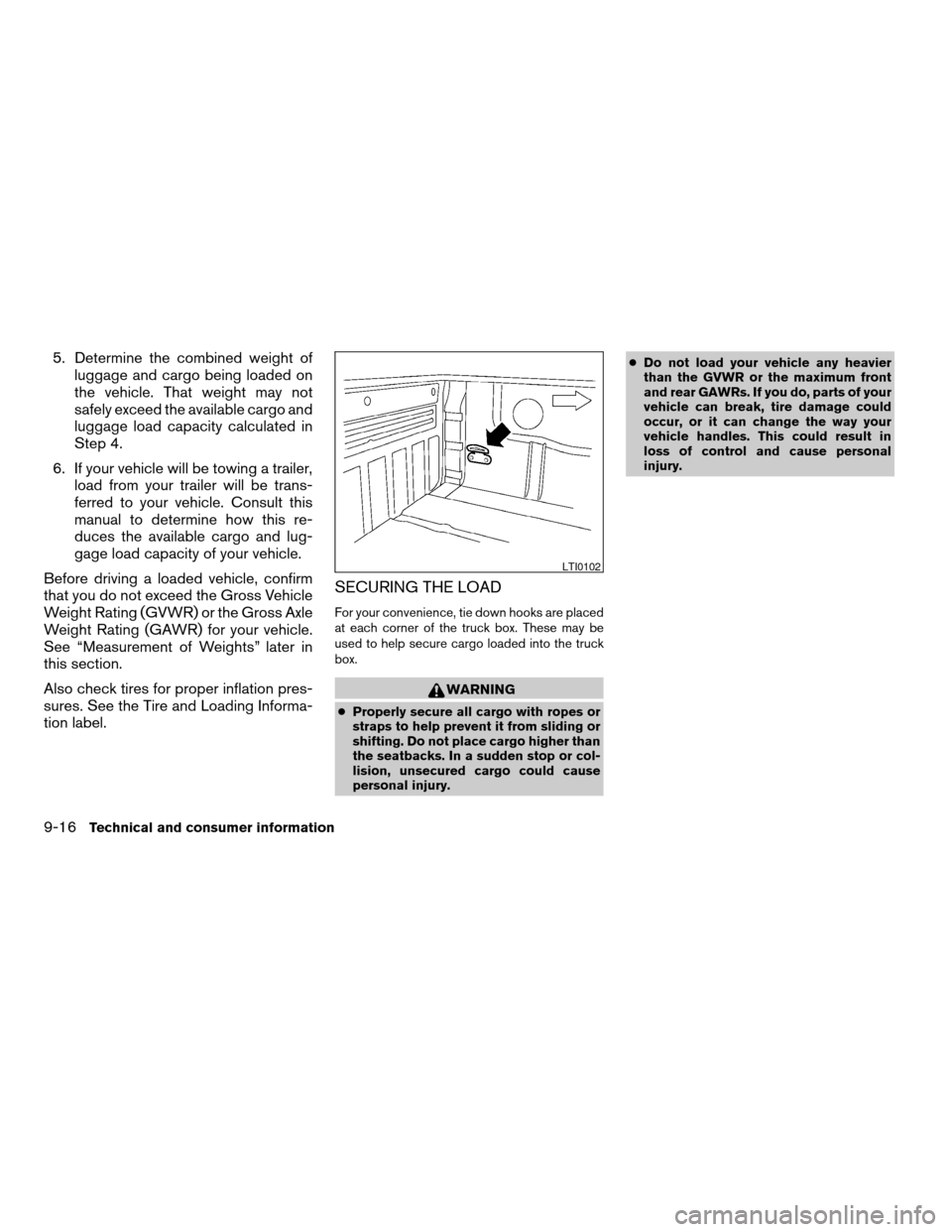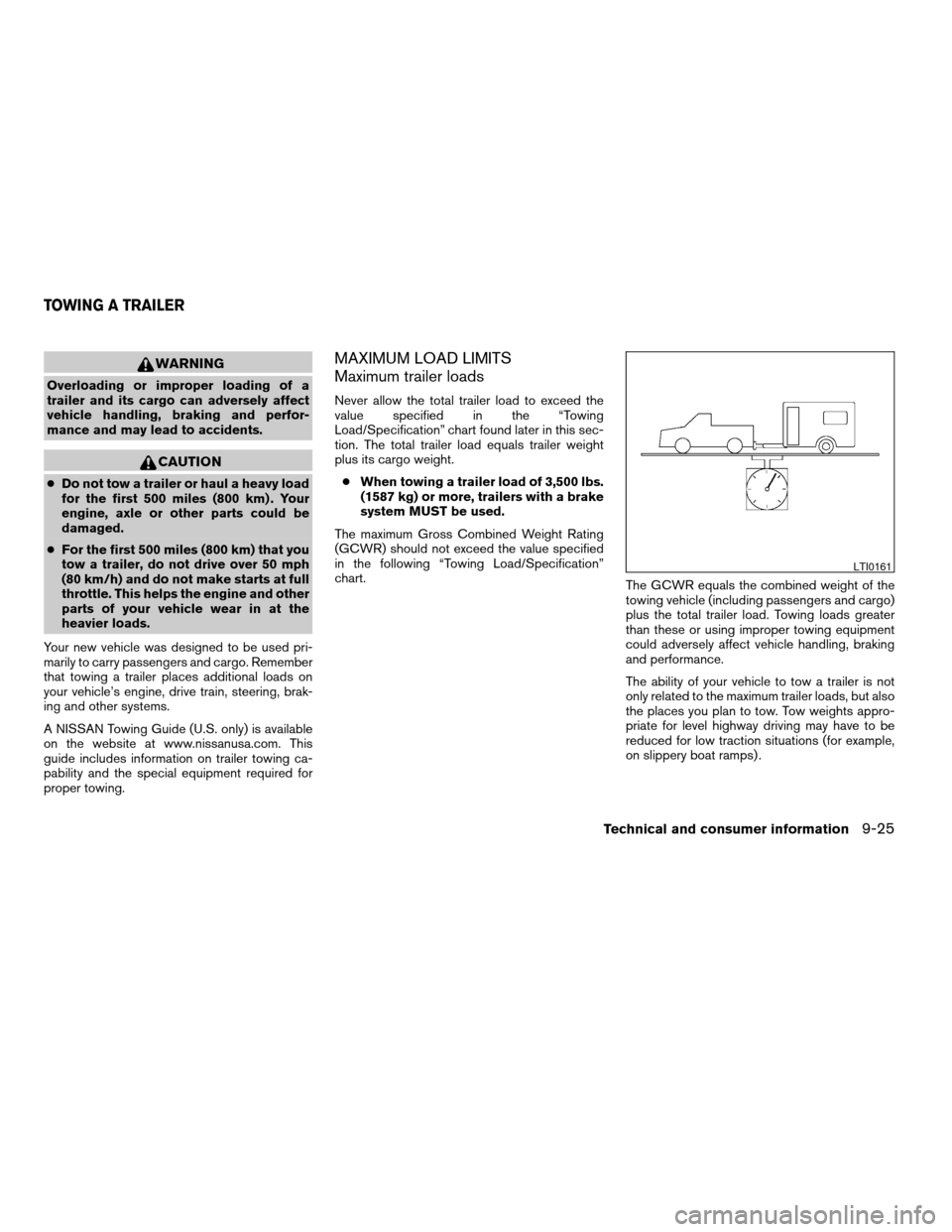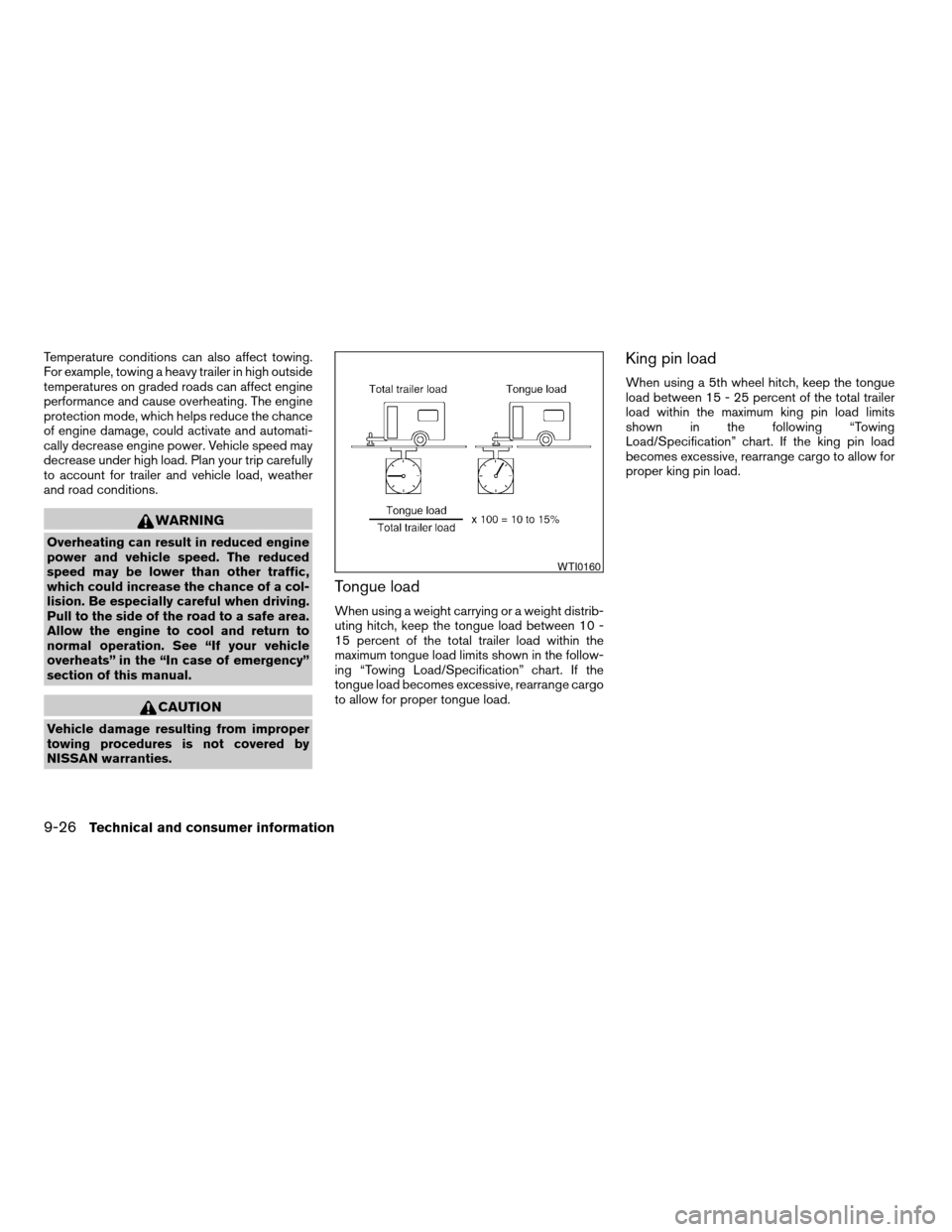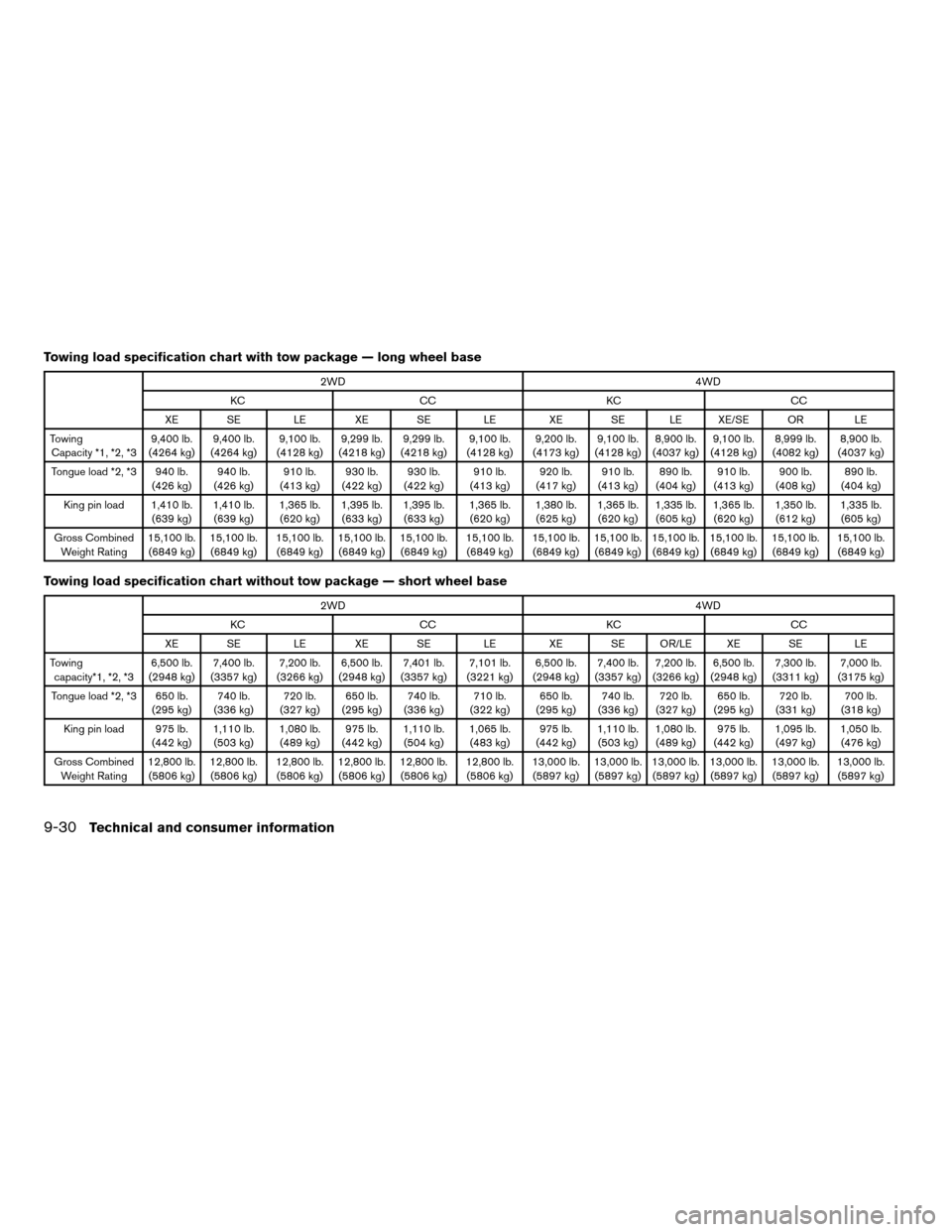2008 NISSAN TITAN towing
[x] Cancel search: towingPage 357 of 408

Oil viscosity
The engine oil viscosity or thickness changes
with temperature. Because of this, it is important
to select the engine oil viscosity based on the
temperatures at which the vehicle will be oper-
ated before the next oil change. Choosing an oil
viscosity other than that recommended could
cause serious engine damage.
Selecting the correct oil filter
Your new NISSAN vehicle is equipped with a
high-quality genuine NISSAN oil filter. When re-
placing, use a genuine NISSAN oil filter or its
equivalent for the reason described in “Change
intervals”.
Change intervals
The oil and oil filter change intervals for your
engine are based on the use of the specified
quality oils and filters. Using engine oil and filters
that are not of the specified quality, or exceeding
recommended oil and filter change intervals
could reduce engine life. Damage to the engine
caused by improper maintenance or use of incor-
rect oil and filter quality and/or viscosity is not
covered by the NISSAN new vehicle limited war-
ranty.Your engine was filled with a high-quality engine
oil when it was built. You do not have to change
the oil before the first recommended change
interval. Oil and filter change intervals depend
upon how you use your vehicle.
Operation under the following conditions may
require more frequent oil and filter changes:
crepeated short distance driving at cold out-
side temperatures
cdriving in dusty conditions
cextensive idling
ctowing a trailer
cstop and go commuting
Refer to the “NISSAN Service and Maintenance
Guide” for the maintenance schedule.
AIR CONDITIONER SYSTEM
REFRIGERANT AND OIL
RECOMMENDATIONS
The air conditioner system in your NISSAN
vehicle must be charged with the refriger-
ant HFC-134a (R-134a) and the oil, NISSAN
A/C system oil Type S or the exact equiva-
lents.
CAUTION
The use of any other refrigerant or oil will
cause severe damage to the air condition-
ing system and will require the replace-
ment of all air conditioner system
components.
The refrigerant HFC-134a (R-134a) in your
NISSAN vehicle does not harm the earth’s ozone
layer. Although this refrigerant does not affect the
earth’s atmosphere, certain government regula-
tions require the recovery and recycling of any
refrigerant during automotive air conditioner sys-
tem service. A NISSAN dealer has the trained
technicians and equipment needed to recover
and recycle your air conditioner system refriger-
ant.
Contact a NISSAN dealer when servicing your air
conditioner system.
Technical and consumer information9-7
ZREVIEW COPYÐ2008 Titan(tzw)
Owners ManualÐUSA_English(nna)
03/06/07Ðtbrooks
X
Page 366 of 408

5. Determine the combined weight of
luggage and cargo being loaded on
the vehicle. That weight may not
safely exceed the available cargo and
luggage load capacity calculated in
Step 4.
6. If your vehicle will be towing a trailer,
load from your trailer will be trans-
ferred to your vehicle. Consult this
manual to determine how this re-
duces the available cargo and lug-
gage load capacity of your vehicle.
Before driving a loaded vehicle, confirm
that you do not exceed the Gross Vehicle
Weight Rating (GVWR) or the Gross Axle
Weight Rating (GAWR) for your vehicle.
See “Measurement of Weights” later in
this section.
Also check tires for proper inflation pres-
sures. See the Tire and Loading Informa-
tion label.
SECURING THE LOAD
For your convenience, tie down hooks are placed
at each corner of the truck box. These may be
used to help secure cargo loaded into the truck
box.
WARNING
cProperly secure all cargo with ropes or
straps to help prevent it from sliding or
shifting. Do not place cargo higher than
the seatbacks. In a sudden stop or col-
lision, unsecured cargo could cause
personal injury.cDo not load your vehicle any heavier
than the GVWR or the maximum front
and rear GAWRs. If you do, parts of your
vehicle can break, tire damage could
occur, or it can change the way your
vehicle handles. This could result in
loss of control and cause personal
injury.
LTI0102
9-16Technical and consumer information
ZREVIEW COPYÐ2008 Titan(tzw)
Owners ManualÐUSA_English(nna)
03/06/07Ðtbrooks
X
Page 375 of 408

WARNING
Overloading or improper loading of a
trailer and its cargo can adversely affect
vehicle handling, braking and perfor-
mance and may lead to accidents.
CAUTION
cDo not tow a trailer or haul a heavy load
for the first 500 miles (800 km) . Your
engine, axle or other parts could be
damaged.
cFor the first 500 miles (800 km) that you
tow a trailer, do not drive over 50 mph
(80 km/h) and do not make starts at full
throttle. This helps the engine and other
parts of your vehicle wear in at the
heavier loads.
Your new vehicle was designed to be used pri-
marily to carry passengers and cargo. Remember
that towing a trailer places additional loads on
your vehicle’s engine, drive train, steering, brak-
ing and other systems.
A NISSAN Towing Guide (U.S. only) is available
on the website at www.nissanusa.com. This
guide includes information on trailer towing ca-
pability and the special equipment required for
proper towing.
MAXIMUM LOAD LIMITS
Maximum trailer loads
Never allow the total trailer load to exceed the
value specified in the “Towing
Load/Specification” chart found later in this sec-
tion. The total trailer load equals trailer weight
plus its cargo weight.
cWhen towing a trailer load of 3,500 lbs.
(1587 kg) or more, trailers with a brake
system MUST be used.
The maximum Gross Combined Weight Rating
(GCWR) should not exceed the value specified
in the following “Towing Load/Specification”
chart.
The GCWR equals the combined weight of the
towing vehicle (including passengers and cargo)
plus the total trailer load. Towing loads greater
than these or using improper towing equipment
could adversely affect vehicle handling, braking
and performance.
The ability of your vehicle to tow a trailer is not
only related to the maximum trailer loads, but also
the places you plan to tow. Tow weights appro-
priate for level highway driving may have to be
reduced for low traction situations (for example,
on slippery boat ramps) .
LTI0161
TOWING A TRAILER
Technical and consumer information9-25
ZREVIEW COPYÐ2008 Titan(tzw)
Owners ManualÐUSA_English(nna)
03/06/07Ðtbrooks
X
Page 376 of 408

Temperature conditions can also affect towing.
For example, towing a heavy trailer in high outside
temperatures on graded roads can affect engine
performance and cause overheating. The engine
protection mode, which helps reduce the chance
of engine damage, could activate and automati-
cally decrease engine power. Vehicle speed may
decrease under high load. Plan your trip carefully
to account for trailer and vehicle load, weather
and road conditions.
WARNING
Overheating can result in reduced engine
power and vehicle speed. The reduced
speed may be lower than other traffic,
which could increase the chance of a col-
lision. Be especially careful when driving.
Pull to the side of the road to a safe area.
Allow the engine to cool and return to
normal operation. See “If your vehicle
overheats” in the “In case of emergency”
section of this manual.
CAUTION
Vehicle damage resulting from improper
towing procedures is not covered by
NISSAN warranties.
Tongue load
When using a weight carrying or a weight distrib-
uting hitch, keep the tongue load between 10 -
15 percent of the total trailer load within the
maximum tongue load limits shown in the follow-
ing “Towing Load/Specification” chart. If the
tongue load becomes excessive, rearrange cargo
to allow for proper tongue load.
King pin load
When using a 5th wheel hitch, keep the tongue
load between 15 - 25 percent of the total trailer
load within the maximum king pin load limits
shown in the following “Towing
Load/Specification” chart. If the king pin load
becomes excessive, rearrange cargo to allow for
proper king pin load.
WTI0160
9-26Technical and consumer information
ZREVIEW COPYÐ2008 Titan(tzw)
Owners ManualÐUSA_English(nna)
03/06/07Ðtbrooks
X
Page 377 of 408

Maximum Gross Vehicle Weight
(GVW)/maximum Gross Axle Weight
(GAW)
The GVW of the towing vehicle must not exceed
the Gross Vehicle Weight Rating (GVWR)
shown on the F.M.V.S.S./C.M.V.S.S. certification
label. The GVW equals the combined weight of
the unloaded vehicle, passengers, luggage,
hitch, trailer tongue load and any other optional
equipment. In addition, front or rear GAW must
not exceed the Gross Axle Weight Rating
(GAWR) shown on the F.M.V.S.S./C.M.V.S.S.
certification label.Towing capacities are calculated assuming a
base vehicle with driver and any options required
to achieve the rating. Additional passengers,
cargo and/or optional equipment, such as the
trailer hitch, will add weight to the vehicle and
reduce your vehicle’s maximum towing capacity
and trailer tongue load.
The vehicle and trailer need to be weighed to
confirm the vehicle is within the GVWR, Front
GAWR, Rear GAWR, Gross Combined Weight
Rating (GCWR) and Towing capacity.
All vehicle and trailer weights can be measured
using platform type scales commonly found at
truck stops, highway weigh stations, building
supply centers or salvage yards.
To determine the available payload capacity for
tongue/king pin load, use the following proce-
dure.
1. Locate the GVWR on the
F.M.V.S.S./C.M.V.S.S. certification label.
2. Weigh your vehicle on the scale with all of
the passengers and cargo that are normally
in the vehicle when towing a trailer.
3. Subtract the actual vehicle weight from the
GVWR. The remaining amount is the avail-
able maximum tongue/king pin load.To determine the available towing capacity, use
the following procedure.
1. Find the GCWR for your vehicle on the
9Towing Load/Specification9chart found
later in this section.
2. Subtract the actual vehicle weight from the
GCWR. The remaining amount is the avail-
able maximum towing capacity.
To determine the Gross Trailer Weight, weigh
your trailer on a scale with all equipment and
cargo, that are normally in the trailer when it is
towed. Make sure the Gross trailer weight is not
more than the Gross Trailer Weight Rating shown
on the trailer and is not more than the calculated
available maximum towing capacity.
Also weigh the front and rear axles on the scale to
make sure the Front Gross Axle Weight and Rear
Gross Axle Weight are not more than Front
Gross Axle Weight and Rear Gross Axle Weight
on the F.M.V.S.S./C.M.V.S.S. certification label.
The cargo in the trailer and vehicle may need to
be moved or removed to meet the specified rat-
ings.
CA0036
Technical and consumer information9-27
ZREVIEW COPYÐ2008 Titan(tzw)
Owners ManualÐUSA_English(nna)
03/06/07Ðtbrooks
X
Page 378 of 408

Example:
cGross Vehicle Weight (GVW) as weighed
on a scale - including passengers, cargo and
hitch - 6,200 lb. (2812 kg) .
cGross Vehicle Weight Rating (GVWR) from
F.M.V.S.S./C.M.V.S.S. certification label -
7,100 lb. (3221 kg) .
cGross Combined Weight Rating (GCWR)
from “Towing Load/Specification9chart -
15,100 lb. (6849 kg) .
cMaximum Trailer towing capacity from “Tow-
ing Load/Specification9chart - 9,200 lb.
(4173 kg) .
7,100 lb. (3221 kg) GVWR
– 6,200 lb. (2812 kg) GVW
= 900 lb. (408 kg) Available for tongue/king
pin weight
15,100 lb. (6849 kg) GCWR
– 6,200 lb. (2812 kg) GVW
= 8,900 lb. (4036 kg) Capacity available for tow-
ing
900 lb. (408 kg) Available tongue weight
/ 8,900 lb. (4036 kg) Available capacity
= 10 % tongue weight
The available towing capacity may be less than
the maximum towing capacity due to the passen-
ger and cargo load in the vehicle.
Remember to keep trailer tongue weight be-
tween 10 - 15% of the trailer weight. If the tongue
load becomes excessive, rearrange the cargo to
obtain the proper tongue load. Do not exceed the
10 - 15% tongue weight specification even if the
calculated available tongue weight is greater
than 15%. If the calculated tongue weight is less
than 10% , reduce the total trailer weight to
match the available tongue weight.
Always verify that available capacities are within
the required ratings.
9-28Technical and consumer information
ZREVIEW COPYÐ2008 Titan(tzw)
Owners ManualÐUSA_English(nna)
03/06/07Ðtbrooks
X
Page 379 of 408

TOWING LOAD/SPECIFICATION
Towing load specification chart with tow package — short wheel base
2WD4WD
KC CC KC CC
XE SE LE XE SE LE XE/SE OR LE XE SE LE
Towing
Capacity *1, *2, *39,500 lb.
(4309 kg)9,500 lb.
(4309 kg)9,200 lb.
(4173 kg)9,400 lb.
(4264 kg)9,400 lb.
(4264 kg)9,100 lb.
(4128 kg)9,400 lb.
(4264 kg)9,300 lb.
(4218 kg)9,200 lb.
(4173 kg)9,200 lb.
(4173 kg)9,100 lb.
(4128 kg)8,900 lb.
(4037 kg)
Tongue load *2, *3 950 lb.
(430 kg)950 lb.
(430 kg)920 lb.
(417 kg)940 lb.
(426 kg)940 lb.
(426 kg)910 lb.
(413 kg)940 lb.
(426 kg)930 lb.
(421 kg)920 lb.
(417 kg)920 lb.
(417 kg)910 lb.
(413 kg)890 lb.
(404 kg)
King pin load 1,425 lb.
(737 kg)1,425 lb.
(737 kg)1,380 lb.
(625 kg)1,410 lb.
(639 kg)1,410 lb.
(639 kg)1,365 lb.
(620 kg)1,410 lb.
(639 kg)1,395 lb
(632 kg)1,380 lb.
(625 kg)1,380 lb.
(625 kg)1,365 lb.
(620 kg)1,335 lb.
(605 kg)
Gross Combined
Weight Rating15,100 lb.
(6849 kg)15,100 lb.
(6849 kg)15,100 lb.
(6849 kg)15,100 lb.
(6849 kg)15,100 lb.
(6849 kg)15,100 lb.
(6849 kg)15,100 lb.
(6849 kg)15,100 lb.
(6849 kg)15,100 lb.
(6849 kg)15,100 lb.
(6849 kg)15,100 lb.
(6849 kg)15,100 lb.
(6849 kg)
Technical and consumer information9-29
ZREVIEW COPYÐ2008 Titan(tzw)
Owners ManualÐUSA_English(nna)
03/06/07Ðtbrooks
X
Page 380 of 408

Towing load specification chart with tow package — long wheel base
2WD4WD
KC CC KC CC
XE SE LE XE SE LE XE SE LE XE/SE OR LE
Towing
Capacity *1, *2, *39,400 lb.
(4264 kg)9,400 lb.
(4264 kg)9,100 lb.
(4128 kg)9,299 lb.
(4218 kg)9,299 lb.
(4218 kg)9,100 lb.
(4128 kg)9,200 lb.
(4173 kg)9,100 lb.
(4128 kg)8,900 lb.
(4037 kg)9,100 lb.
(4128 kg)8,999 lb.
(4082 kg)8,900 lb.
(4037 kg)
Tongue load *2, *3 940 lb.
(426 kg)940 lb.
(426 kg)910 lb.
(413 kg)930 lb.
(422 kg)930 lb.
(422 kg)910 lb.
(413 kg)920 lb.
(417 kg)910 lb.
(413 kg)890 lb.
(404 kg)910 lb.
(413 kg)900 lb.
(408 kg)890 lb.
(404 kg)
King pin load 1,410 lb.
(639 kg)1,410 lb.
(639 kg)1,365 lb.
(620 kg)1,395 lb.
(633 kg)1,395 lb.
(633 kg)1,365 lb.
(620 kg)1,380 lb.
(625 kg)1,365 lb.
(620 kg)1,335 lb.
(605 kg)1,365 lb.
(620 kg)1,350 lb.
(612 kg)1,335 lb.
(605 kg)
Gross Combined
Weight Rating15,100 lb.
(6849 kg)15,100 lb.
(6849 kg)15,100 lb.
(6849 kg)15,100 lb.
(6849 kg)15,100 lb.
(6849 kg)15,100 lb.
(6849 kg)15,100 lb.
(6849 kg)15,100 lb.
(6849 kg)15,100 lb.
(6849 kg)15,100 lb.
(6849 kg)15,100 lb.
(6849 kg)15,100 lb.
(6849 kg)
Towing load specification chart without tow package — short wheel base
2WD4WD
KC CC KC CC
XE SE LE XE SE LE XE SE OR/LE XE SE LE
Towing
capacity*1, *2, *36,500 lb.
(2948 kg)7,400 lb.
(3357 kg)7,200 lb.
(3266 kg)6,500 lb.
(2948 kg)7,401 lb.
(3357 kg)7,101 lb.
(3221 kg)6,500 lb.
(2948 kg)7,400 lb.
(3357 kg)7,200 lb.
(3266 kg)6,500 lb.
(2948 kg)7,300 lb.
(3311 kg)7,000 lb.
(3175 kg)
Tongue load *2, *3 650 lb.
(295 kg)740 lb.
(336 kg)720 lb.
(327 kg)650 lb.
(295 kg)740 lb.
(336 kg)710 lb.
(322 kg)650 lb.
(295 kg)740 lb.
(336 kg)720 lb.
(327 kg)650 lb.
(295 kg)720 lb.
(331 kg)700 lb.
(318 kg)
King pin load 975 lb.
(442 kg)1,110 lb.
(503 kg)1,080 lb.
(489 kg)975 lb.
(442 kg)1,110 lb.
(504 kg)1,065 lb.
(483 kg)975 lb.
(442 kg)1,110 lb.
(503 kg)1,080 lb.
(489 kg)975 lb.
(442 kg)1,095 lb.
(497 kg)1,050 lb.
(476 kg)
Gross Combined
Weight Rating12,800 lb.
(5806 kg)12,800 lb.
(5806 kg)12,800 lb.
(5806 kg)12,800 lb.
(5806 kg)12,800 lb.
(5806 kg)12,800 lb.
(5806 kg)13,000 lb.
(5897 kg)13,000 lb.
(5897 kg)13,000 lb.
(5897 kg)13,000 lb.
(5897 kg)13,000 lb.
(5897 kg)13,000 lb.
(5897 kg)
9-30Technical and consumer information
ZREVIEW COPYÐ2008 Titan(tzw)
Owners ManualÐUSA_English(nna)
03/06/07Ðtbrooks
X